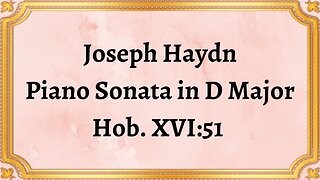Premium Only Content

Henry Purcell Fantasias in Four Parts
#MusicAppreciation #BaroqueComposers #ChamberEnsemble #MusicHistory #MusicalAnalysis #HenryPurcellLegacy #FantasiaPerformance #OrchestralMelodies #EnglishBaroque #MelodicMasterpiece #MusicalInspiration
Henry Purcell Fantasias in Four Parts
Publication date 1951
Winterthur String Orchestra Walter Goehr, conductor
1. Fantasias In Four Parts: Fantasias No. 1 In G Major
2. Fantasias In Four Parts: Fantasias No. 2 In B Flat Major
3. Fantasias In Four Parts: Fantasias No. 3 In F Major
4. Fantasias In Four Parts: Fantasias No. 4
5. Fantasias In Four Parts: Fantasias No. 5 In D Minor
6. Fantasias In Four Parts: Fantasias No. 6 In A Minor
7. Fantasias In Four Parts: Fantasias No. 7
8. Fantasias In Four Parts: Fantasias No. 8 In G Major
9. Fantasias In Four Parts: Fantasias No. 9
Henry Purcell, one of England's most celebrated composers, left an indelible mark on the world of music with his innovative compositions. Among his notable works, the Fantasias in Four Parts hold a significant place.
The Fantasias in Four Parts were composed during the late 17th century, a period known for its flourishing musical landscape. Purcell, deeply rooted in English musical traditions, crafted these fantasies as a response to the growing interest in instrumental chamber music. These compositions were intended to be performed by a small ensemble of string instruments, typically two violins, a viola, and a cello.
Purcell's Fantasias in Four Parts encompass a collection of eight pieces, each showcasing the composer's exceptional skill and musical inventiveness.
Purcell's Fantasias are characterized by intricate counterpoint, where multiple melodic lines intertwine and complement each other. The composer skillfully weaves together different musical voices, creating a rich tapestry of harmonies and melodic patterns. This contrapuntal complexity adds depth and interest to each piece.
Within the Fantasias, Purcell displays his ability to create contrasting textures and moods. Some movements are lively and energetic, while others exude a more introspective and melancholic atmosphere. The interplay of these varying emotions adds emotional depth and captivates the listener.
Purcell's Fantasias demonstrate his mastery of harmonic language. The composer skillfully employs unexpected chord progressions and harmonic shifts, often surprising the listener with unexpected turns of phrase. This harmonic inventiveness showcases Purcell's unique musical voice and adds intrigue to the compositions.
Henry Purcell's Fantasias in Four Parts have endured the test of time, capturing the imagination of musicians and audiences alike. These compositions continue to be studied, performed, and admired for their technical brilliance and expressive qualities. The Fantasias have served as a source of inspiration for subsequent generations of composers, highlighting Purcell's profound influence on the development of English Baroque music.
Henry Purcell's Fantasias in Four Parts remain a testament to the composer's exceptional talent and artistic vision. Through their intricate counterpoint, varied textures, and harmonic innovations, these compositions exemplify the beauty and complexity of Baroque chamber music. Purcell's enduring legacy is evident in the continued appreciation and exploration of his Fantasias, solidifying his position as a distinguished figure in the history of Western classical music. As we celebrate the brilliance of Purcell's Fantasias in Four Parts, we recognize their significance in shaping the musical landscape of their time and beyond.
You have the opportunity to support the channel https://destream.net/live/RadSiarAl/donate
-
 6:07
6:07
Classical music_Music Inspiration
1 month agoJoseph Haydn Piano Sonata in D Major, Hob. XVI:51
861 -
 LIVE
LIVE
Right Side Broadcasting Network
7 hours agoLIVE: President Trump and UK Prime Minister Starmer Meet and Hold a Press Conference - 2/27/25
7,539 watching -
 2:12:33
2:12:33
Adam Carolla
2 days agoKamala Harris vs. Trump Wildfire Response + Jillian Michaels on Motherhood/Ayahuasca & Sperm Donors!
4.85K6 -
 LIVE
LIVE
Barry Cunningham
6 hours agoTRUMP DAILY BRIEFING: PRESIDENT TRUMP AND UK PRIME MINISTER STARMER HOLD PRESS CONFERENCE!
2,485 watching -
 1:44:47
1:44:47
The Quartering
3 hours agoEpstein Files RELEASED Today, Gene Hackman Mystery & Trump Vs Woke Reporters!
51.9K22 -
 1:19:38
1:19:38
Ben Shapiro
3 hours agoEp. 2147 - HUGE: The Washington Post SURRENDERS…To Reality!
56.5K13 -
 1:01:36
1:01:36
Russell Brand
17 hours agoThe Battle for Power: Trump’s Plan, Elon’s Purge & the DEI Illusion – SF545
159K49 -
 1:58:33
1:58:33
The Charlie Kirk Show
4 hours agoAmerica's Spiritual Revival + Runaway Judges + Vivek For Ohio | Habba, Waggoner, Vivek | 2.27.2025
106K13 -
 58:33
58:33
The Dan Bongino Show
6 hours agoAmerica's A-Team Hits The Ground Running (Ep. 2432) - 02/27/2025
769K1.16K -
 1:19:38
1:19:38
The Rubin Report
5 hours agoCNN Host Brutally Mocked for Trying to Profit Off of What He Called a ‘Conspiracy’
82.5K47